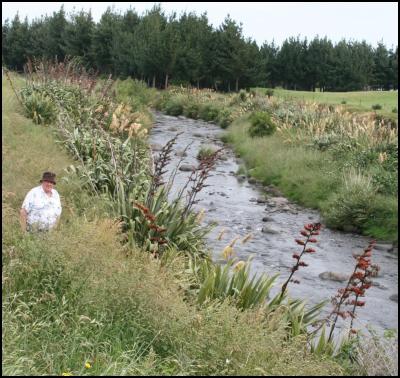Dollars And Sense In Streamside Planting
Dollars And Sense In Streamside Planting

Click for big version
Caption: Kaponga farmer Tom Gibson with well-established riparian planting on the banks of the Kaupokonui Stream.
Kaponga farmer Tom Gibson knows all about the value of stock. And about the value of streamside fences and plants.
A keen enthusiast for riparian (streamside) fencing and planting, he reckons it’s well worth the investment.
“I’d have to say, the cost of planting is a lot less than the cost of the stock I was losing,” he says. And that was even before the current large dairy payouts, which have pushed cow prices up to $2,500-$3,000 a head – enough to pay a contractor to put in around 800m of tax-deductible riparian fencing.
Mr Gibson has been implementing a riparian management plan on his 100 ha property for five years. And he’s had the benefit of hard lessons from earlier forays into streamside work, seeing stock demolish new plantings after flood-damaged fences weren’t repaired quickly enough.
Now it’s smooth sailing, however, with a contractor taking care of the hard graft and Mr Gibson happy to see the end of stock being lost by drowning or by being bogged.
“At calving time the cows would head for the streams, and often come down with milk fever. If you weren’t there when they got up again, they’d get into the stream and drown,” he says.
Liver fluke is another lurking peril for animals drinking from streams, while agricultural research has also shown that cows drinking from reticulated troughs tend to walk less, eat more and do better than cows drinking from streams.
For these reasons and more, Mr Gibson says riparian fencing and planting has made farm and stock management much easier – providing shelter, for example, making stock movement safer, and making break feeding simpler because the temporary line can be strung across the paddock to a fence alongside a stream.
He also appreciates the protection and enhancement of water quality – the reason that riparian fencing and planting is among the targets under the Dairying and Clean Streams Accord Regional Action Plan agreed to by Federated Farmers, Fonterra and the Taranaki Regional Council.
Properly established riparian buffers filter sediment and pollution, and reduce the speed of run-off, which moderates stream flows and reduces flooding.
Riparian buffers also provide food and shelter for wildlife and corridors for plants and birds. Streamside vegetation also reduces water temperatures and supplies food for aquatic insects that in turn provide food for fish.
“Land in Taranaki is among the most valuable in the world,” says Mr Gibson. “And it’s the same with the waterways. We need to keep them as clean and pristine as possible.”
He also sees riparian management as complementing his other environmental investments in such things as effluent systems and pumps. “We’ve gone to a lot of expense over the years and we need to protect that.”
Farmers interested in obtaining riparian management plans, or wanting advice on implementing existing plans, can call the Taranaki Regional Council and ask to speak to a Land Management Officer.
ENDS


 Business Canterbury: Urges Council To Cut Costs, Not Ambition For City
Business Canterbury: Urges Council To Cut Costs, Not Ambition For City Wellington Airport: On Track For Net Zero Emissions By 2028
Wellington Airport: On Track For Net Zero Emissions By 2028 Landcare Research: ANZAC Gall Fly Release Promises Natural Solution To Weed Threat
Landcare Research: ANZAC Gall Fly Release Promises Natural Solution To Weed Threat NZ Anti-Vivisection Society: Auckland Rat Lovers Unite!
NZ Anti-Vivisection Society: Auckland Rat Lovers Unite! University of Canterbury: $1.35 Million Grant To Study Lion-like Jumping Spiders
University of Canterbury: $1.35 Million Grant To Study Lion-like Jumping Spiders Federated Farmers: Government Ends War On Farming
Federated Farmers: Government Ends War On Farming



